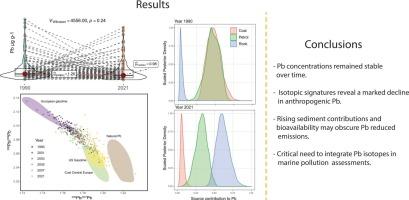褐藻捕获的东北大西洋自然铅的回归
IF 11.3
1区 环境科学与生态学
Q1 ENGINEERING, ENVIRONMENTAL
引用次数: 0
摘要
铅是一种具有严重生态影响的剧毒污染物。研究了东北大西洋(n = 446)褐藻Fucus spp.中Pb浓度的30年变化趋势(1990-2021)和同位素特征(206Pb/207Pb和208Pb/206Pb)。铅浓度仅略有下降,无显著性下降21.9%。相比之下,同位素数据显示了从人为来源到自然来源的明显转变。贝叶斯混合模型(MixSIAR)支持这一趋势,表明自然贡献增加,从1990年的4.7%上升到2021年的61.5%,反映了煤炭燃烧(从48.4%下降到6.3%)和汽油相关来源(从46.9%下降到32.2%)的减少。浓度和同位素趋势之间的差异可能反映了沉积物来源铅的大幅增加(2021年为189.3%,而1990-2007年为13-49%),以及海洋酸化等环境变化推动的生物利用度增强。在以黑角藻为主的河口内带,铅含量呈升高趋势,但物种间无纬向分布和同位素差异。总的来说,这些发现突出了沿海生态系统中铅的复杂动态以及仅仅依靠浓度数据来评估污染趋势的局限性。同位素分析已被证明对铅源归属至关重要,它揭示了向天然铅源的逐渐转变,并支持诸如全球逐步淘汰含铅汽油等监管措施的有效性。然而,该研究强调,由酸化和其他全球环境变化驱动的铅生物利用度的增加可能抵消了减少排放的好处。最后,这项工作为这些数据仍然稀缺的地区提供了有价值的同位素基线,支持未来的环境监测和来源追踪工作。本文章由计算机程序翻译,如有差异,请以英文原文为准。

The Return of Natural Lead to the Northeast Atlantic Ocean Captured by Brown Algae
Lead (Pb) is a highly toxic pollutant with serious ecological implications. This study investigates 30-year trends (1990-2021) in Pb concentrations and isotopic signatures (206Pb/207Pb and 208Pb/206Pb) in the brown algae Fucus spp. from the Northeast Atlantic Ocean (n = 446). Pb concentrations showed only modest, non-significant 21.9% decline. In contrast, isotopic data revealed a clear shift from anthropogenic to natural sources. Bayesian mixing models (MixSIAR) supported this trend, indicating an increase in natural contributions, rising from 4.7% in 1990 to 61.5% in 2021, mirroring reductions in coal combustion (from 48.4% to 6.3%) and petrol-related sources (from 46.9% to 32.2%). This divergence between concentrations and isotopic trends likely reflects a substantial increase in sediment-derived Pb (189.3% in 2021 compared to 13-49% during 1990-2007), as well as enhanced bioavailability driven by environmental changes such as ocean acidification. Elevated Pb levels were found in inner estuarine zones dominated by Fucus ceranoides, but no latitudinal pattern or isotopic differences among species were observed. Overall, the findings highlight the complex dynamics of Pb in coastal ecosystems and the limitations of relying solely on concentration data to assess pollution trends. Isotope analyses have proven essential for source attribution, revealing a progressive shift toward natural Pb sources and supporting the effectiveness of regulatory measures such as the global phase-out of leaded gasoline. However, the study underscores that increased Pb bioavailability, driven by acidification and other global environmental changes, may offset the benefits of reduced emissions. Finally, this work provides a valuable isotopic baseline for a region where such data remain scarce, supporting future environmental monitoring and source-tracing efforts.
求助全文
通过发布文献求助,成功后即可免费获取论文全文。
去求助
来源期刊

Journal of Hazardous Materials
工程技术-工程:环境
CiteScore
25.40
自引率
5.90%
发文量
3059
审稿时长
58 days
期刊介绍:
The Journal of Hazardous Materials serves as a global platform for promoting cutting-edge research in the field of Environmental Science and Engineering. Our publication features a wide range of articles, including full-length research papers, review articles, and perspectives, with the aim of enhancing our understanding of the dangers and risks associated with various materials concerning public health and the environment. It is important to note that the term "environmental contaminants" refers specifically to substances that pose hazardous effects through contamination, while excluding those that do not have such impacts on the environment or human health. Moreover, we emphasize the distinction between wastes and hazardous materials in order to provide further clarity on the scope of the journal. We have a keen interest in exploring specific compounds and microbial agents that have adverse effects on the environment.
 求助内容:
求助内容: 应助结果提醒方式:
应助结果提醒方式:


